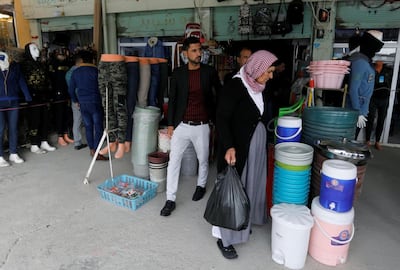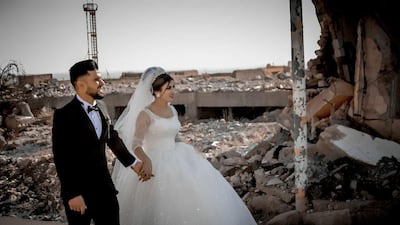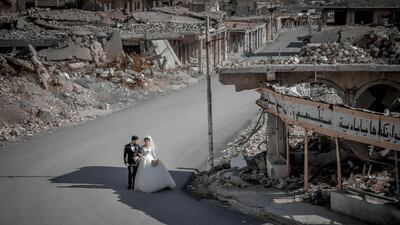Hala Safil Amo anxiously awaits news of her mother and sister’s fates as the UN excavates a Yazidi mass grave in the Sinjar region of Iraq in an attempt to identify ISIS victims.
Six years has passed since the extremist group's genocide campaign against the Yazidi people and hundreds, just like Ms Safil Amo, are now trying to find the bodies of their loved ones.
"It is very difficult to say that we will feel any comfort in finding our loved ones buried in the graves," she told The National.
"But thousands of people are missing and their families are waiting to hear confirmed news about their fate."
The UN in October began work in the villages of Solagh and Kojo in the northern province, home to the ethno-religious Yazidi minority whose members were killed in their thousands by ISIS.
On Wednesday, the UNITAD's chief forensic anthropologist told The National that his team was soon to return the remains of victims found in the mass graves to their families.
Ms Safil Amo hopes the findings will shed light on the scale of murder and torture meted out by ISIS against the religious minority.
The Yazidis were persecuted by ISIS as "devil worshippers" but descend from some of the region's most ancient roots.
For safety, the Yazidi traditionally held themselves apart in small communities mainly scattered across north-west Iraq, north-west Syria and south-east Turkey.
So far, 17 mass graves have been uncovered by the authorities in Sinjar, containing the bodies of almost 3,000 Yazidis killed by ISIS.
Between 2014 and 2016, ISIS militants shot, beheaded and burnt alive the group’s members and kidnapped thousands, especially its women, many of whom were forced into sexual slavery.
Ms Safil Amo, a survivor of unimaginable violence, lost her family to the insurgents.
She and her female family members were abducted by ISIS fighters when they occupied Sinjar on August 3, 2014.
Ms Safil Amo was forced to go to Mosul city where she was raped several times, leaving her to consider taking her own life.
“One of the most difficult situations I found myself in was when I witnessed them rape a nine-year-old girl,” she said.
There was nothing she could do to stop it.
Iraq, which declared victory over ISIS in 2017, has yet to call the group's crimes against the Yazidis genocide, despite the UN recognition.
Ms Safil Amo said that for more than six years the local government has remained silent about the suffering the group endured.
“We’ve lost our faith and trust in them,” she said.
The mass graves represent unequivocal, concrete evidence of the genocide committed against the Yazidi people, said Murad Ismael, executive director of Yazda, a global organisation supporting the Yazidi people.
"The Mothers’ Grave [which contains the remains of nearly 80 women] represented a deep and a particular importance because it held remains of Yazidi women who were treated with a cruelty not seen in modern times," Mr Ismael said.
Holding ISIS to account through DNA
Under pressure from human rights lawyer Amal Clooney and Yazidi survivors, the UN Security Council in 2017 created an investigative team to help Iraq collect and preserve evidence for future prosecution of ISIS criminals.
Many suspects have been prosecuted for membership of ISIS, rather than for the specific atrocities they committed.
"Information gathered from the excavation and interpretation of the crime scene is used to support criminal investigations and can be presented in criminal trials as expert testimony," the UN team's chief forensic expert, Caroline Barker, told The National.
The purpose of the excavation is to find forensic evidence related to ISIS crimes.
To identify each victim, investigators require DNA samples from relatives to perform kinship matching.
Living relatives are an important part in the identification process, Ms Barker said.
“DNA profiles obtained from bone and tooth samples of the mortal remains of the victims are compared with DNA profiles donated by families of victims who are still missing," she said.
A computer search is then performed to establish DNA matches and evaluate the strength of those matches between living relatives and victims whose remains were exhumed.

“DNA match reports are issued when the level of certainty of a specified family relationship reaches or exceeds the threshold of 99.95 per cent,” Ms Barker said.
But Ms Safil Amo feels that the process of exhuming graves and identifying victims is moving too slowly.
She fears that mass graves in Sinjar that are yet to found will be swept away by rain, meaning traces of human remains will be destroyed.
“I hope that … the opening of all graves in the Sinjar region will be accelerated," she said.
Yazidis are still missing after they were abducted from Sinjar by the militants.
The survivors are believed to be living among ISIS families held in detention by Syrian Kurdish forces in neighbouring Syria.
Ms Safil Amo escaped from ISIS after Iraqi and coalition forces started freeing neighbourhoods in Mosul from the insurgents.
She is now living in a displacement camp in the Kurdistan Region of Iraq.












